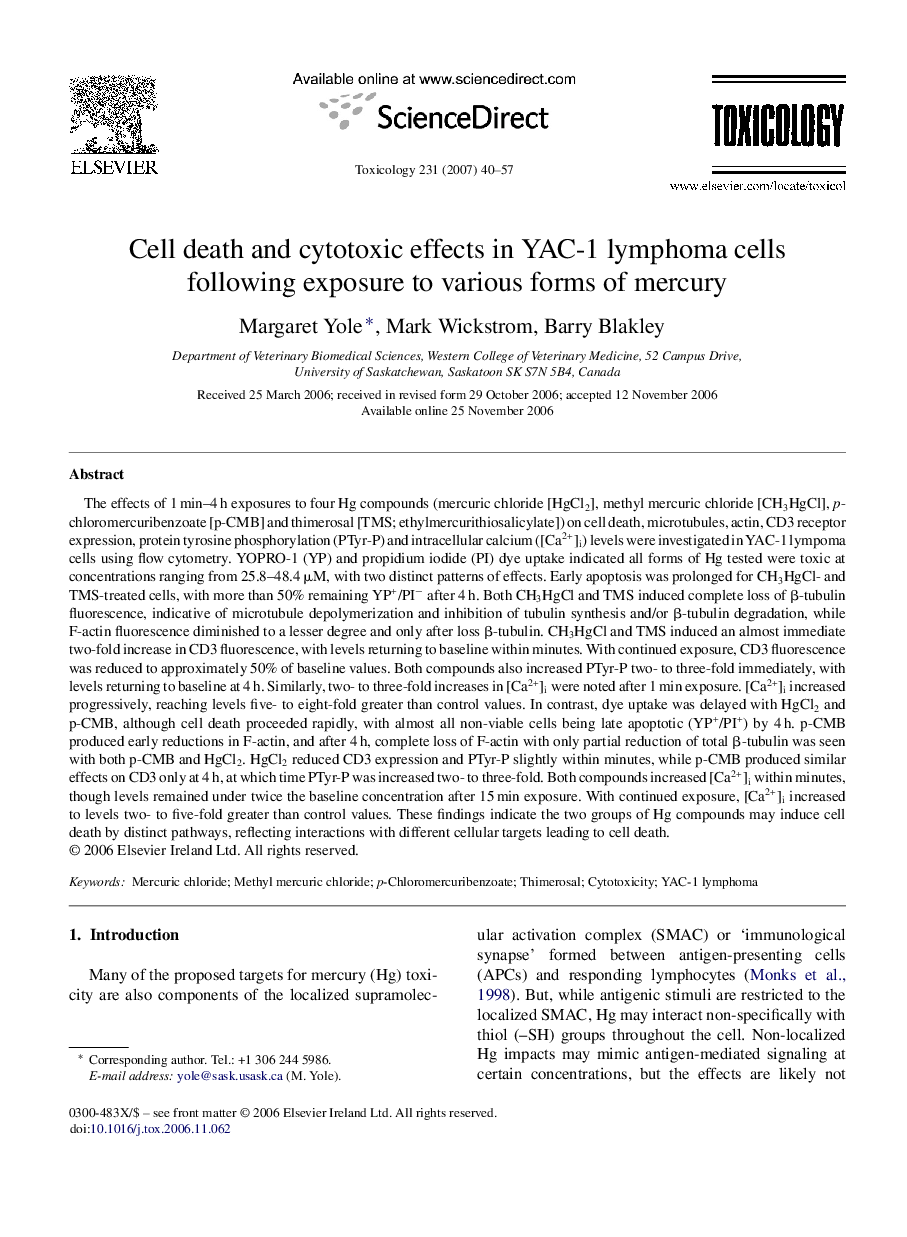| کد مقاله | کد نشریه | سال انتشار | مقاله انگلیسی | نسخه تمام متن |
|---|---|---|---|---|
| 2598027 | 1132609 | 2007 | 18 صفحه PDF | دانلود رایگان |
عنوان انگلیسی مقاله ISI
Cell death and cytotoxic effects in YAC-1 lymphoma cells following exposure to various forms of mercury
دانلود مقاله + سفارش ترجمه
دانلود مقاله ISI انگلیسی
رایگان برای ایرانیان
کلمات کلیدی
موضوعات مرتبط
علوم زیستی و بیوفناوری
علوم محیط زیست
بهداشت، سم شناسی و جهش زایی
پیش نمایش صفحه اول مقاله

چکیده انگلیسی
The effects of 1 min-4 h exposures to four Hg compounds (mercuric chloride [HgCl2], methyl mercuric chloride [CH3HgCl], p-chloromercuribenzoate [p-CMB] and thimerosal [TMS; ethylmercurithiosalicylate]) on cell death, microtubules, actin, CD3 receptor expression, protein tyrosine phosphorylation (PTyr-P) and intracellular calcium ([Ca2+]i) levels were investigated in YAC-1 lympoma cells using flow cytometry. YOPRO-1 (YP) and propidium iodide (PI) dye uptake indicated all forms of Hg tested were toxic at concentrations ranging from 25.8-48.4 μM, with two distinct patterns of effects. Early apoptosis was prolonged for CH3HgCl- and TMS-treated cells, with more than 50% remaining YP+/PIâ after 4 h. Both CH3HgCl and TMS induced complete loss of β-tubulin fluorescence, indicative of microtubule depolymerization and inhibition of tubulin synthesis and/or β-tubulin degradation, while F-actin fluorescence diminished to a lesser degree and only after loss β-tubulin. CH3HgCl and TMS induced an almost immediate two-fold increase in CD3 fluorescence, with levels returning to baseline within minutes. With continued exposure, CD3 fluorescence was reduced to approximately 50% of baseline values. Both compounds also increased PTyr-P two- to three-fold immediately, with levels returning to baseline at 4 h. Similarly, two- to three-fold increases in [Ca2+]i were noted after 1 min exposure. [Ca2+]i increased progressively, reaching levels five- to eight-fold greater than control values. In contrast, dye uptake was delayed with HgCl2 and p-CMB, although cell death proceeded rapidly, with almost all non-viable cells being late apoptotic (YP+/PI+) by 4 h. p-CMB produced early reductions in F-actin, and after 4 h, complete loss of F-actin with only partial reduction of total β-tubulin was seen with both p-CMB and HgCl2. HgCl2 reduced CD3 expression and PTyr-P slightly within minutes, while p-CMB produced similar effects on CD3 only at 4 h, at which time PTyr-P was increased two- to three-fold. Both compounds increased [Ca2+]i within minutes, though levels remained under twice the baseline concentration after 15 min exposure. With continued exposure, [Ca2+]i increased to levels two- to five-fold greater than control values. These findings indicate the two groups of Hg compounds may induce cell death by distinct pathways, reflecting interactions with different cellular targets leading to cell death.
ناشر
Database: Elsevier - ScienceDirect (ساینس دایرکت)
Journal: Toxicology - Volume 231, Issue 1, 28 February 2007, Pages 40-57
Journal: Toxicology - Volume 231, Issue 1, 28 February 2007, Pages 40-57
نویسندگان
Margaret Yole, Mark Wickstrom, Barry Blakley,